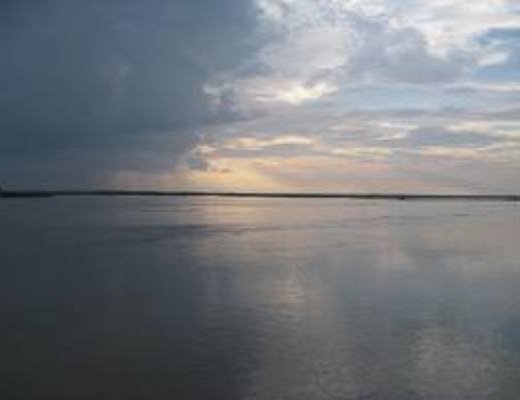
As echoed by many of our countrymen, the Kosi high dam would be extremely harmful to the economy of our mid hill region where this dam impounding a vast reservoir would have to be built. Despite serious negative impact of the Kosi high dam on our economy and environment, our country must not walk away from the plan to implement this project because this is the most suitable project to provide our landlocked country direct deep waterway access to sea if implemented based on 1997 Kosi study agreement signed between Nepal and India. Needless to say this dam project inclusive of a navigation canal extending from Chatra in Nepal to Ganges would have enormous economic as well as political significance for our landlocked country.
Vital Significance of Access to Sea
Access to sea has always been regarded to have great economic as well as political significance even for those countries that are not landlocked, like our country Nepal. The most recent glaring example is the Israel's struggle to get access to the Red Sea.
Egypt's denial of access to the Strait of Tiran which controls Israel's entrance to Red Sea featured prominently in the events which led to two major Arab-Israel Conflicts that could have ended up into World War. This happened in 1956 and again in 1967. It should be noted that the Israel had gone into all out war against the combined forces of Arab countries even risking its own existence despite the fact that the ship traffic destined for Israel at Eilat passing through Strait of Tirana was relatively low compared to Israel's two large seaports on the Mediterranean.
Landlocked Nepal and Underdevlopment
All those involved in the economic development of Nepal agree that poverty, backwardness and under-development have resulted, to a great extent, from our country being landlocked. However, Nepal is not the only landlocked country in the world. Even developed countries like Switzerland and Austria are landlocked. Those countries are able to overcome this difficult hurdle. They have succeeded in opening inland waterways suited for operation of large river vessels that are providing them unhindered access to the sea. Those countries have big river harbours to handle incoming and outgoing goods transported by waterways without any worry as to the nature of cargoes, maximum allowable size of the goods etc in transit. After all, water-borne transportation is the cheapest mode of transportation. It would not be an exaggeration to say that those landlocked countries have overcome their geography constraints. Now-a-days the coastal river carriers (CRC vessels) can directly link those countries to the near by sea ports of the rest of the Europe.
Kosi Navigation Canal
According to 1997 Kosi Study Agreement signed between Nepal and India, detailed study of the Kosi high dam would be carried out along with the detailed study of a navigation canal linking Chatra with the Ganges that would provide our country direct waterway access to sea. The proposed canal would also be used as main irrigation canal as well as for generation of electricity. A very similar example is the use of canal drawing water from the Upper Rheine River for navigation and power generation. According to 1919 Versailles Treaty the Rheine River was diverted providing Switzerland direct deep waterway access to sea.
Switzerland's Access to Sea
The Rheine between Basle in Switzerland and Iffezheim is almost entirely canalised. On a stretch of 180 kilometres , there are 10 dams , provided with hydropower stations and locks. Between Basle and Breisach, the old river bed carries hardly any water; almost all water is diverted through the Grand Canal d'Alsace on the French side to ensure safe shipping and hydropower generation around the clock. Only when there is a large supply of water, then the old river bed receives more water than the canal. France gained the right to do this based on the 1919 Treaty of Versailles. The right applies to the segment between Basle and Neuburgweier / Lauterbourg, where the Rhine forms the border between France and Germany.
History of Navigation Canals in China and Europe
As the oldest and longest man-made canal in the world, the Beijing-Hangzhou Grand Canal is 1,794 kilometers long with a history of over 2,500 years, and it starts at Beijing in the north and ends at Hangzhou in the south, running through Tianjin, Hebei Province, Shandong Province, Jiangsu Province and Zhejiang Province along its way. The Beijing-Hangzhou Grand Canal links five great rivers, the Hai River, the Huai River, the Yangtze River, the Yellow River and the Qiantang River.
In Europe the canal navigation era started towards the end of the 17th century. France took the lead, integrating its national waterway system further by forging the missing links. In the north, the Saint-Quentin Canal, with a 3.5 mile tunnel, opened in 1810, linking the North Sea and the Schelds and Lys systems with the English Channel via the Somme and with Paris and Le Havre via the Oise and Seine. The Rhine- Rhone Canal, opened in 1834, provided a direct north-to-south route. The Sambre-Oise Canal linked the French canal system with the Belgian network via the Meuse.
In Germany in the late 17th and early 18th centuries the three great rivers, the Elb, Oder, and Weser, were linked by canals. The Ludwig Canal, forming part of the Rhine-Main-Danube route, was opened in 1840. A nationwide Russian canal system connecting the Baltic and Caspian seas via the Neva and Volga rivers became navigable in 1718. In the 19th century Russia made connections between the heads of navigation of its great rivers, the Volga, Dnepr, Don, Dvina, and Ob.
The Most Recently Built Navigation Canal
An example of the most recent navigation canal is the 171 km Main-Danube Canal in Germany completed very recently in 1990s. The canal winds through some of the most challenging, scenic, and environmentally sensitive landscape of Germany. The Altmuhl Valley traversed by the canal is one of the most beautiful and environmentally fragile area in Bavaria. It is this factor that lies behind a long and often passionate opposition to this project. However, Germany did not listen to the environmentalists opposing the canal scheme who regarded the canal as the end of the Altmuhl valley. Stair step locks on the Main River lift barge traffic to Bamburg, the northern entry point to the canal. From there, 11 locks raise ships to the highest point on any commercial waterway in Europe, about 180 m above Bamburg. Five more locks then lower vessels to Kelheim, the southern terminus of the canal. The waterway will accommodate huge Euro-barges carrying up to 2,425 tons of bulk cargo, the equivalent of 78 truck trailers!

Dr. A.B. Thapa
Thapa writes on water resources issue
- Dudhkosi Multipurpose Project
- Jul 11, 2022
- Dudh-Kosi Power Project And Kosi Treaty
- Sep 27, 2021
- Uttarakhand Glaciers And Recent Disaster: A Lesson To Our Country
- Mar 02, 2021
- Multipurpose Langtang After Melamchi: Inter-Basin Water Transfer
- Nov 04, 2020
- Large Storage Dams Projects Wary of Giving Away Children’s Inheritance
- Dec 22, 2019
















